This essay is adapted from Chapter 16 of Outdoor Monuments of Manhattan: A Historical Guide. I’ve kept cross-references to other chapters in the book, all of which will eventually be updated and posted on this site. Click on “Outdoor Monuments of Manhattan book” in the Obsessions cloud at lower right to see which are already here.
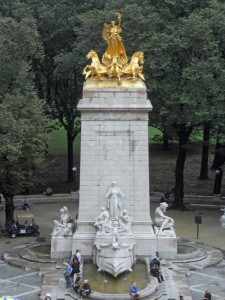
- Sculptor: Attilio Piccirilli; architect H. van Buren Magonigle
- Dedicated: 1913
- Medium and size: Marble pedestal (44 feet), gilded bronze group on top (16.5 feet), 9 marble figures at base (over life-size)
- Location: Central Park at Columbus Circle (intersection of Eighth Avenue, 59th Street and Central Park South)
About the sculpture
Lying awake grieving over a lost lover, you might wail, “Don’t you know I can’t sleep at night / Since you’ve been gone,” or you might lament:
How can I then return in happy plight,
That am debarr’d the benefit of rest?
When day’s oppression is not eased by night,
But day by night, and night by day, oppress’d? (Shakespeare, Sonnet XXVIII)
Art must express an idea in a vivid image, but “vivid” does not necessarily mean ordinary and unadorned. In fact, the more unusual the images or words, the more likely you’ll notice and remember them. With its eleven allegorical figures, the Maine Monument ranks among Manhattan’s largest and most complex memorials. To understand its message requires knowledge of a specific historical event. Once you do understand it, though, it’s a memorable and moving work.
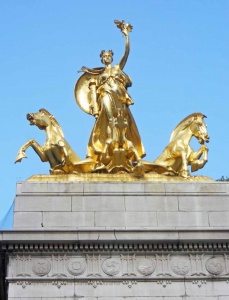
Atop the Maine Monument gilt figures flash in the sun, catching our attention despite their position high above the sidewalk. The woman is Columbia Triumphant, i.e., the United States. We know this not because of her action or anything she holds, but because the artist gave her that title. She carries a fasces, the bundle of sticks tied around an axe that symbolized government power to the Romans. (See Washington at Wall Street, Chapter 6.) Her shield gives her a martial air. Like Sherman’s Victory (Chapter 31), she holds aloft an olive or laurel wreath, symbolizing victory or peace. A trio of seahorses draws her chariot, emphasizing that the United States is a power at sea as well as on land. Because the Columbia group is so prominently placed on the Monument, and because it alone is gilded, the dominant theme of the Monument is the triumph of American naval power.
The groups around the base, in contrast, remind us that the Spanish-American War began with a naval disaster. (See About the Subject, below.) On either side of the pylon (tapering pillar) on which Columbia stands, a youth and an old man symbolize the Atlantic and the Pacific Oceans, the theaters of the war.
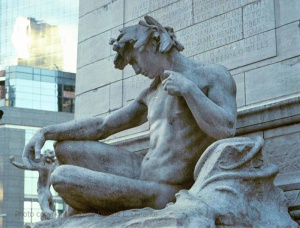
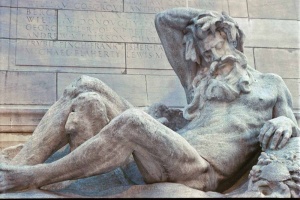
Above them, inscriptions name those who died in the Maine explosion.
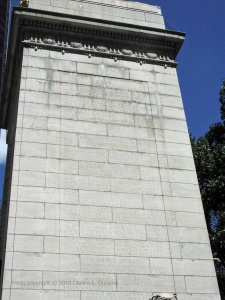
On the front of the pylon is the inscription: “To the valiant seamen who perished on the Maine, by fate unwarned, in death unafraid.”
Kneeling at the prow of a ship at the front of the pylon is a young boy who once held two metal wreaths, again symbolizing peace and victory. They’ve been stolen so often that they’re rarely replaced.
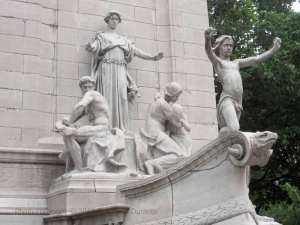
Against the pylon’s front face, the calm figure of Peace is flanked by a man (the strong, silent type) and a woman soothing a crying child. The artist entitled this group “The Antebellum State of Mind: Courage Awaiting the Flight of Peace and Fortitude Supporting the Feeble.” I take this to mean that after the Maine exploded but before war was declared, Peace still reigned, Courage sat around with nothing to do (and resented it, judging from his expression) and Fortitude comforted those who grieved over the Maine’s victims.
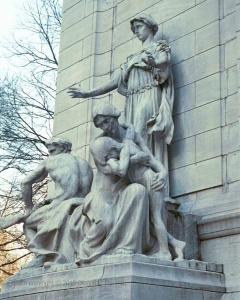
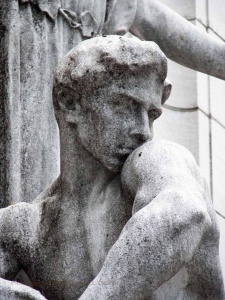
Moving around to the back of the Monument, we see at the center Justice, her eyes closed rather than blindfolded. She probably held a pair of scales in one hand (for weighing facts) and with the other, reached for a sword (to execute her decisions) held out by the warrior on our left. The scales and sword, added in metal, have also been stolen. On our right, History records the events of the war.

The artist entitled this group “The Post-Bellum Idea: Justice Receiving Back the Sword Entrusted to War.” Justice has triumphed, the fighters have turned in their weapons, and glorious feats are being recorded for posterity.
The message of this complex monument is that the United States fought a just war to avenge the seamen who died on the Maine, and emerged triumphant. Because Columbia appears in gilt on top of the Monument, the emphasis is on the triumph of the United States rather than the deaths of the seamen. Imagine the difference if, instead, Fortitude and the crying child, or the figures of dead seamen, were atop the pylon. The Monument implies that Americans can successfully defend themselves and their values. Innocents may die, but they will not die unavenged.
This work does not stand on its own: you need an explanation to understand what’s going on. So what’s the difference between this work, with its lengthily titled allegorical figures, and Noguchi’s Unidentified Object (cf. News, Chapter 30)?
To understand the Maine Monument we must know that it relates to the Spanish-American War. Once we do, however, the various allegorical figures work together to convey a message about that war, by means of the details included, color, composition, and so on. One cannot make a case that this Monument might just as well commemorate the Civil War, the Erie Canal or Breakfast at Tiffany’s.
That said, it is an esthetic flaw that the Monument’s meaning isn’t clear unless we know the titles given by the sculptor to the individual groups. (See Lincoln, Chapter 15.) The best visual art stands on its own, without verbal explanations.
About the subject
Historians often imply that Americans, romping through the Gilded Age, were lured into the Spanish-American war by the clamor of the sensationalist press regarding the 1898 explosion of the USS Maine. The roots of the Spanish-American War, however, extend much further back than newspaper stories of early 1898.
By the late nineteenth century, Cuba was the only part of the Americas still under Spanish dominion. Cuban rebels had failed to win independence after a bloody ten-year war in the 1860s. For many Americans, the solution was obvious: annex Cuba. Cuba would be free of Spain’s oppressive monarchical rule. In turn, Cuba would supply the United States with cheap raw materials such as sugar and tobacco, and would provide a new market for American goods.
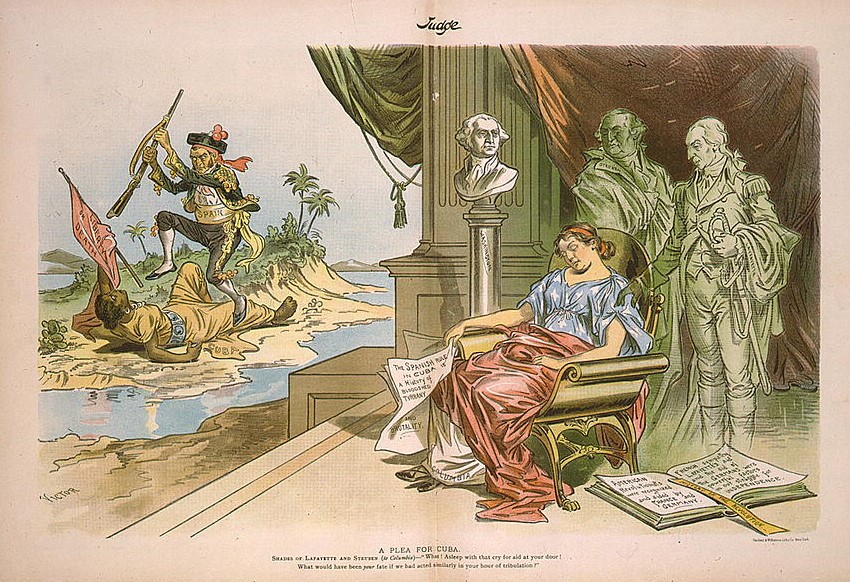
José Martí’s 1895 call for renewed military action against the Spanish (Chapter 33) began another brutal war. Most Americans favored the rebels. McKinley’s 1896 presidential platform included support for Cuban independence. In December 1896, newspapers transformed an exchange of shots between a Spanish patrol boat and an American filibuster boat smuggling arms to Cuba into “The First Naval Battle of the Cuban War.” A few months later, the press transmuted a suspected female spy searched by a matron in the privacy of a ship’s cabin into a beautiful, naked girl surrounded by leering Spanish sailors.
Spain, under a new Liberal government, decreed that Cuba would be given home rule in early 1898. This pleased neither the rebels, who wanted complete independence, nor the loyalists, who feared retribution if Spanish troops were withdrawn. Violence was expected to erupt in February, when elections were scheduled. To protect American lives and property as well as to indicate support for the new Spanish government, the United States sent the battleship Maine to Havana in late January.
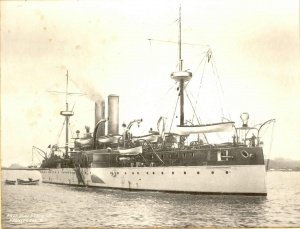
At 9:40 on the balmy night of February 15, five tons of gunpowder aboard the USS Maine exploded, almost obliterating a third of the ship. The bow was ripped open. The mast and smokestacks toppled. Nearby Spanish vessels rushed to pick up survivors, but two hundred sixty-six sailors – about three-quarters of the ship’s complement of 350 – died, most as they slept.
Captain Sigsbee telegraphed to the secretary of the Navy:
Maine blown up in Havana harbor at nine forty tonight and destroyed. Many wounded and doubtless more killed or drowned. . . . Public opinion should be suspended until further report.
In the United States, speculation ran rife about the cause of the horrific explosion. It must have been a mine planted by the Spaniards . . . or by Cuban independence fighters, or by loyalists who wanted Spain to remain in Cuba. Perhaps it resulted from a short-circuited dynamo aboard the Maine, or spontaneous combustion within the coal bunkers (imprudently situated next to the ammunition storage), or spontaneous combustion of the gun cotton used in the ship’s torpedoes, or a boiler malfunction. (Brief analysis here.)
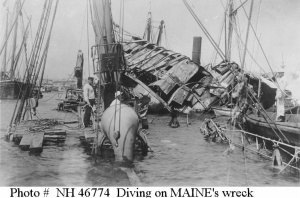
Fans of forensic crime dramas such as CSI might expect that it would be immediately evident whether the explosion’s source was internal or external. Given the state of technology and forensic science at the time, it was not. Massive damage from the initial explosion was compounded by the detonation of the ammunition, and by fire and salt water. Divers staggered about the wreck in 200-pound suits, with electric lights that barely penetrated the murky water. Underwater photography was impossible. (Captain Charles Morgan left a gruesomely vivid description of diving into the wreck of the Maine in 1898, to search for the cause of the explosion.)
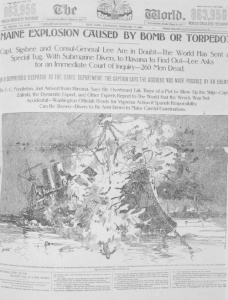
With evidence about the cause of the Maine’s explosion inconclusive, New York newspapers became major players in the Cuban question. Hearst’s Journal printed a drawing—completely fictitious—showing Spanish divers fastening a mine to the Maine’s hull.
The Journal devoted eight pages a day, week after week, to the Maine and Cuba. Pulitzer’s World, battling the Journal for circulation, printed equally belligerent reports. Within a few months Americans were chanting, “Remember the Maine! To hell with Spain!” By June, Theodore Roosevelt (Chapter 42) and the Rough Riders sailed off to war. Two months later the war ended. By 1899, Carl Schurz was lecturing against American imperialism in the Philippines, which the United States had taken over by the peace treaty with Spain (Chapter 51).

The Maine Monument Commission …
A few days after the explosion aboard the Maine, William Randolph Heart’s New York Journal set out to raise funds for a memorial. Hearst originally planned for the memorial to be at the mouth of New York Harbor. Then it was slated instead for Times Square, but a public restroom was built on the designated spot. Finally it was erected at the southwest corner of Central Park, where its size balances that of the Columbus Monument, erected in 1892.
The Columbia group that tops the monument was cast from bronze recovered from the Maine. Also created from the bronze recovered from the Maine were a thousand plaques designed by Charles Keck and cast in 1913. The Maine Monument has one of these attached to its northeast side.
 copy.jpg)
Who can touch this plaque without feeling a shiver?
…and critical reaction
When the Maine Monument was first exposed to public view in 1913, The Sun published scathing comments about it:
Leading artists of the city, although many of them decline to allow their names to be published before a formal protest is made, maintain that the monument in its present form disfigures the beautiful park entrance. They object to the pink tint of the marble, an alleged difference in scale between the figures at the base and the gilded group at the top, and say that there is a lack of harmony in the whole composition. The Art Commission may be asked to consider the substitution of another group for the gilded Columbia and her dolphin horses on top of the pedestal.
“This monument is a disgrace to the city,” said Leon Dabo, one of the founders of the Association of American Painters and Sculptors, to a Sun reporter last night. “It is a misfit,” he continued, “and spoils the beautiful park entrance. And what has it to do with the Maine? Unless some one told us that it was a Maine Memorial Monument, we would never know it from the design. What possible relationship these various groups have to one another is still a mystery. Architecturally and constructively, the whole thing is cheap and bad.” – The Sun, 5/18/1913
Two months earlier, the Association of American Painters and Sculptors had sponsored the 1913 Armory Show – famous for introducing to America modern art such as Duchamp’s Nude Descending a Staircase. Leon Dabo, their spokesman to the Sun, was known for paintings that showed little but open sea, sky, or fields. Allegorical figures were sooooo not his thing.
Bronze plaque
Using bronze recovered from the Maine, a thousand plaques designed by Charles Keck were cast in 1913. The Maine Monument has one of these attached to its northeast side, facing Central Park. I dare you to touch it without feeling a shiver. (Some sources state that the Columbia group that tops the monument was also cast from bronze recovered from the Maine, but there seems to be some doubt about that.)
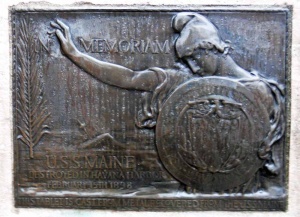
More
- In 1898 Frederic Remington, later famous as a painter and sculptor of the American West, sent a cable to Hearst, at the New York Journal, from Cuba: “There is no war. Request to be recalled.” Hearst replied, “Please remain. You furnish the pictures, I’ll furnish the war.”
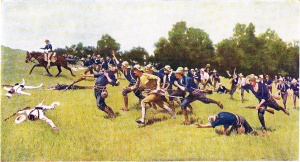
- Attilio Piccirilli (1866-1945) was member of a family of Tuscan stonecutters whose studio was in the Bronx. The Piccirillis carved for Daniel Chester French (including the Continents at the Customs House, Chapter 4, and the Lincoln in the Lincoln Memorial in Washington), and for John Quincy Adams Ward (including the New York Stock Exchange pediment), plus works such as the lions outside New York Public Library, 1911 (Fifth Avenue at 42nd Street), parts of the Washington Arch, ca. 1895-1918 (Chapter 12), and the Pulitzer Fountain, 1916 (Fifth Avenue at 58th Street). Of Attilio’s own design are the sculptures on the Maine Monument and the Firemen’s Memorial, both 1913 (Chapters 34, 45), as well as Youth Leading Industry and the Joy of Life at Rockefeller Center, ca. 1936 and 1937 (636 Fifth Avenue and 15 West 48th Street, respectively), the pediments of the Frick Art Reference Library (71st Street off Fifth Avenue), and the doors of the Riverside Church (Riverside Drive at 122nd Street). Brooklyn has Indian Literature and Indian Law Giver, ca. 1900 (Brooklyn Museum). The Bronx has Columbus (East 183rd Street, Crescent Avenue and Adams Street) and Outcast, 1908 (Woodlawn Cemetery).
- In Getting More Enjoyment from Sculpture You Love, I demonstrate a method for looking at sculptures in detail, in depth, and on your own. Learn to enjoy your favorite sculptures more, and find new favorites. Available on Amazon in print and Kindle formats. More here.
- Want wonderful art delivered weekly to your inbox? Check out my free Sunday Recommendations list and rewards for recurring support: details here.
